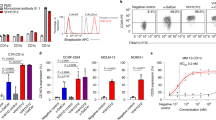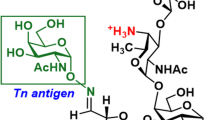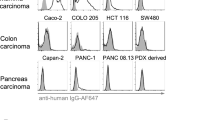Abstract
R24, a mouse monoclonal antibody against GD3 ganglioside, exhibits a wide range of in vitro effector functions. It also has the ability to bind to itself, presumably through homophilic Fab-Fab interactions, which have been proposed to contribute to its high relative avidity for GD3 and to its effector function activity. It is not known which of these characteristics is necessary for the antitumor effects observed in melanoma patients treated with R24. A mouse-human chimeric R24 (chR24) molecule has been constructed in which the GD3-binding site is preserved. Chimeric R24 demonstrates a lower level of binding to GD3 than does mouse R24 suggesting that there may be some differences between the GD3-binding sites of the two mAb or that Fc determinants can contribute to R24 avidity for GD3. The property of homophilic binding is retained by chR24, demonstrating formally that homophilic binding of R24 involves interactions between variable domains. Both R24 and chR24 fix human complement and mediate antibody-dependent cellular cytotoxicity although chR24 was slightly less efficient at the latter. Unlike R24, chR24 was not able to inhibit melanoma cell attachment to plastic surfaces and was not able to activate human T lymphocytes. We hypothesize that chR24 does not bind to GD3 with an avidity high enough to mediate these effector functions.
Similar content being viewed by others
References
Bajorin DF, Chapman PB, Dimaggio J, Coit DG, Kunicka JE, Wong G, Cordon-Cardo C, Urmacher C, Dantis L, Templeton MA, Oettgen HF, Houghton AN (1990) Phase I evaluation of a combination of monoclonal antibody R24 and interleukin 2 in patients with metastatic melanoma. Cancer Res 50: 7490
Chapman PB, Houghton AN (1991) Induction of IgG antibodies against GD3 in rabbits by an anti-idiotypic monoclonal antibody. J Clin Invest 88: 186
Chapman PB, Lonberg M, Houghton AN (1990) Light-chain variants of an IgG3 anti-GD3 monoclonal antibody and the relationship between avidity, effector functions, tumor targeting, and antitumor activity. Cancer Res 50: 1503
Chapman PB, Yuasa H, Houghton AN (1990) Homophilic binding of mouse monoclonal antibodies against GD3 ganglioside. J Immunol 145: 891
Cheresh DA, Pierschbacher MD, Herzig MA, Mujoo K (1986) Disialogangliosides GD2 and GD3 are involved in the attachment of human melanoma and neuroblastoma cells to extracellular matrix. J Cell Biol 102: 688
Cheresh DA, Pytela R, Pierschbacher MD, Klier FG, Ruoslahti E, Reisfeld RA (1986) An Arg-Gly-Asp-directed receptor on the surface of human melanoma cells exists in a divalent cation-dependent functional complex with the disialoganglioside GD2. J Cell Biol 105: 1167
Colcher D, Milenic D, Roselli M, Raubitschek A, Yarranton G, King D, Adair J, Whittle N, Bodmer M, Schlom J (1989) Characterization and biodistribution of recombinant and recombinant/chimeric constructs of monoclonal antibody B72.3. Cancer Res 49: 1738
Cooper LJN, Schimenti JC, Glass DD, Greenspan NS (1991) H chain C domains influence the strength of binding of IgG for streptococcal group A carbohydrate. J Immunol 146: 2659
Dippold WG, Lloyd KO, Li L, Ikeda H, Oettgen HF, Old LJ (1980) Cell surface antigens of human malignant melanoma: definition of six antigenic systems with mouse monoclonal antibodies. Proc Natl Acad Sci USA 77: 6114
Gillies SD, Lo K-M, Wesolowski J (1989) High-level expression of chimeric antibodies using adapted cDNA variable region cassettes. J Immunol Methods 125: 191
Greenspan NS, Dacek DA, Cooper LJN (1988) Fc region-dependence of IgG3 anti-streptococcal group A carbohydrate antibody functional affinity. I. The effect of temperature. J Immunol 12: 4276
Greenspan NS, Monafo WJ, Davie JM (1987) Interaction of IgG3 anti-streptococcal group A carbohydrate (GAC) antibody with streptococcal group A vaccine: enhancing and inhibiting effects of anti-GAC, anti-isotypic, and anti-idiotypic antibodies. J Immunol 138: 285
Greenspan NS, Dacek DA, Cooper LJN (1989) Cooperative binding of two antibodies to independent antigens by an Fc-dependent mechanism. FASEB J 3: 2203
Iliopoulos D, Ernst C, Steplewski Z, Jambrosic JA, Rodeck U, Herlyn M, Clark WH Jr, Koprowski H, Herlyn D (1989) Inhibition of metastases of a human melanoma xenograft by monoclonal antibody to GD2/GD3 gangliosides. J Natl Cancer Inst 81: 440
Liu AY, Robinson RR, Hellstrom KE, Murray ED Jr., Chang CP, Hellstrom I (1987) Chimeric mouse-human IgG1 antibody that can mediate lysis of cancer cells. Proc Natl Acad Sci USA 84: 3439
Liu AY, Robinson RR, Murray ED Jr, Ledbetter JA, Hellstrom I, Hellstrom KE (1987) Production of a mouse-human chimeric monoclonal antibody to CD20 with potent Fc-dependent biologic activity. J Immunol 139: 3521
Marchitto KS, Kindsvogel WR, Beaumier PL, Fine SK, Gilbert T, Levin SD, Woodhouse CS, Morgan AC (1989) Characterization of a human-mouse chimeric antibody reactive with a human melanoma associated antigen. Prog Clin Biol Res 288: 101
Mueller BM, Romerdahl CA, Gillies SD, Reisfeld RA (1990) Enhancement of antibody-dependent cytotoxicity with a chimeric anti-GD2 antibody. J Immunol 144: 1382
Nakamura K, Koike M, Shitara K, Kuwana Y, Kiuragi K, Igarashi S, Hasegawa M, Hanai N (1994) Chimeric anti-ganglioside GM2 antibody with antitumor activity. Cancer Res 54: 1511
Pukel CS, Lloyd KO, Travassos LR, Dippold WG, Oettgen HF, Old LJ (1982) GD3, a prominent ganglioside of human melanoma. Detection and characterization by mouse monoclonal antibody. J Exp Med 155: 1133
Shaw DR, Khazaeli MB, LoBuglio AF (1988) Mouse/human chimeric antibodies to a tumor-associated antigen: biologic activity of the four human IgG subclasses. J Natl Cancer Inst 80: 553
Vadhan-Raj S, Cordon-Cardo C, Carswell EA, Mintzer D, Dantis L, Duteau C, Templeton MA, Oettgen HF, Old LJ, Houghton AN (1988) Phase I trial of a mouse monoclonal antibody against GD3 ganglioside in patients with melanoma: induction of inflammatory responses at tumor sites. J Clin Oncol 6: 1636
Welt S, Carswell EA, Vogel C-W, Oettgen HF, Old LJ (1987) Immune and nonimmune effector functions of IgG3 mouse monoclonal antibody R24 detecting the disialoganglioside GD3 on the surface of melanoma cells. Clin Immunol Immunopathol 45: 214
Welte K, Miller G, Chapman PB, Yuasa H, Natoli E, Kunicka JF, Cordon-Cardo C, Buhrer C, Old LJ, Houghton AN (1987) Stimulation of T cell lymphocyte proliferation by monoclonal antibodies against GD3 ganglioside. J Immunol 139: 1763
Author information
Authors and Affiliations
Additional information
Supported by Public Health Service grants PO1-CA33049 and RO1-CA57363
Rights and permissions
About this article
Cite this article
Chapman, P.B., Gillies, S.D., Houghton, A.N. et al. Mapping effector functions of a monoclonal antibody to GD3 by characterization of a mouse-human chimeric antibody. Cancer Immunol Immunother 39, 198–204 (1994). https://doi.org/10.1007/BF01533387
Received:
Accepted:
Issue Date:
DOI: https://doi.org/10.1007/BF01533387




